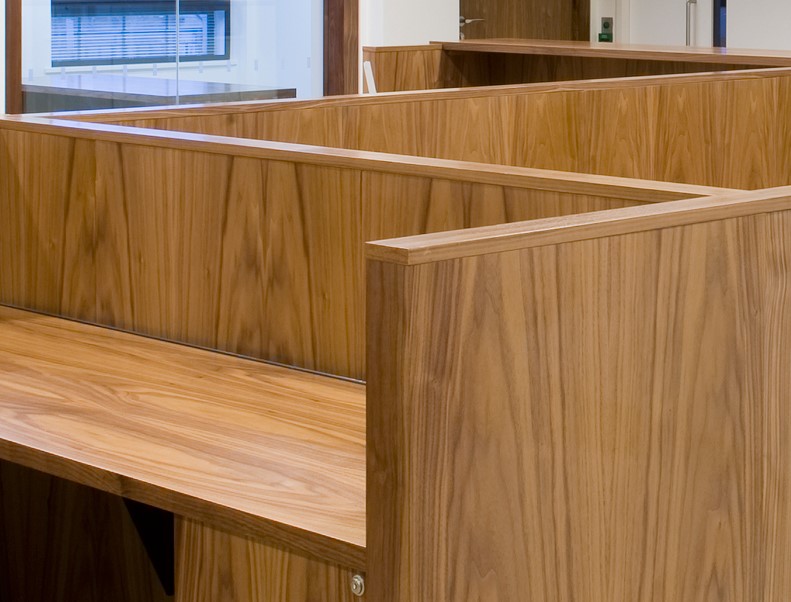Corners and joins that are exposed to view are usually enhanced by the adding or moulding of an "Edge". There are many forms that an edge can take, all are pressed and joined to a panel either by machine or hand; depending on its size, complexity and scale.
One of the largest machines in our factory is responsible for bonding, trimming and buffing the edges applied to our panels. This allows us to produce identical finishes each time with accuracy to the millimetre.
The choice of edge finish is an important one, our gallery below highlights some of the different options available. When making your edge selection there are three main components to your choice; Thickness (size), Shape and Material.
Edge Material
Edging panels and tops is important for the overall look of furniture. Your choice of material will determine availability for size, shape, colour and texture.
Traditional wood veneered panels have a hardwood or veneered edge, these allow for the greatest variety of shapes and ensure durability. Alongside the traditional veneered or solid timber edges, we can also edge your panels with durable ABS or Melamine.
When choosing your Edge material, you should consider the same information as choosing your panel face/reverse finish. More detail on this is available on the veneer section of our site.
Hardwood/Solid Timber Edge offers wide customisation options for mouldings, shapes, cuts and provides a unique finish. The traditional and most popular method of edging a veneered panel.
Edge Veneer gives the same overall look as hardwood but can be a more cost-effective solution, available on certain edge shapes only. (Edge Veneer is 0.6mm thick)
2mm Edge Veneer gives durability and protection whilst maintaining the flexibility of standard edge veneer. When combined with a 2mm radius edge, 2mm edge veneer gives a smooth feel similar to those offered by ABS/Laminate options.
ABS/Melamine Edging is very durable, offers a uniform finish (regardless of scale) and an unlimited range of colours and textures. These materials cannot be moulded to bullnose or bullet edge shape.
Exposed Edges leaves the core of chipboard, MDF or (most commonly) plywood open. Commonly used as cost-saving method for hidden edges, although increasingly requested as a design feature. Exposed edges still require treatment and a lacquer before being shipped.
Edge Shape
Terminology for edge shape varies depending on industry, company and even down to individual craftsman. On this page are the standard terms for the basic types of edge we produce. As with all Griffiths & Hood products this is only a sample of the edges we can offer thanks to our investment in the latest machinery and development and retention of skilled staff.
Square
A square edge is the most common and cost effective option. The top and side of the panel are at 90 degrees to each other.
Available on any material types and matched to the edge thickness, any veneer type can be pressed to a square finish.
Bullnose
A bullnose edge is fully rounded, running a smooth curve from the panel top to its underside. The measurement of the bullnose edge is relative to the panel, the radius of the curve measures at half the thickness of the panel.
Undercut (Chamfer)
An undercut chamfer has a short straight edge at the top with an angled underside reaching the bottom of the panel.
This style of edge is most commonly applied to boardroom tables.
An undercut chamfer creates the impression of a thinner, lighter piece with the benefit of retaining strength and durability.
Radius
A radius edge is straight with small curves at the top, bottom or both corners to smooth the transition from the panel top and/or bottom to it's edge. The measurement of the edge is in millimetres (mm), representing (as the name suggests) the radius of the curve.
Bullet
A bullet edge is similar to a bullnose but is not fully rounded. The top and bottom of the edge run a shallow curve from the panel. The end of the edge can have a have either a short flat edge or a tight curved finish.
A Combination of Edges
Edge types can be combined to create unique perimeters to your piece. For example a radius chamfer would soften the top edge before leading into an undercut to give the impression of a lighter piece.
Bespoke Edges
These are only a sample of edging types. All Griffiths & Hood products and detail are bespoke to your design. We have the capability, experience and knowledge to produce almost any edge design.

![Syon-Clinic-Exec[1] (2).jpg](https://images.squarespace-cdn.com/content/v1/59d4e845edaed8e83ad6d176/1516621121350-M5V6GZTLD8X5KI2FIXU9/Syon-Clinic-Exec%5B1%5D+%282%29.jpg)








